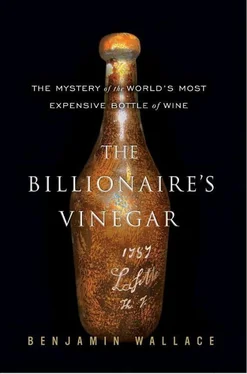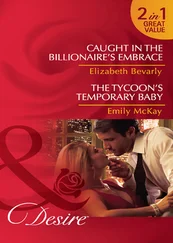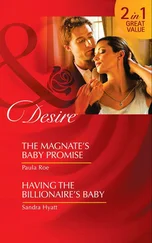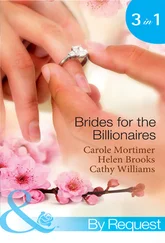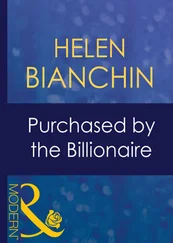Journalists loved tallying the prorated cost of the wine: $19,500 a glass, $4,000 a sip, $795 “for each year of the life” of the wine. Citroën ran an ad making fun of the bottle’s price compared with the mere £4,165 cost of its “Van Rouge.” In a cartoon that ran in a British newspaper, a paunchy, red-nosed airplane passenger passed a bottle around to his friends while turning to a seat neighbor who appeared to be having a heart attack: “I’ve just opened your duty-free, mate—I’ll get you another bottle when she comes round!” Some muggins of an American, reveling in all the publicity, had the best of these framed and added to the gallery of press clippings that winds around the hallways of the Forbes magazine executive offices on lower Fifth Avenue.
There was a fair amount of moralizing about the purchase. Hand-wringing pundits spoke of Jefferson “[turning] over in his grave” because of the extravagance, or because of the Forbeses’ stated intention of putting the bottle in a museum. Wine experts proffered sniffy opinions on whether the Lafite would be drinkable. Bordeaux château owners eagerly hoped the price would have a trickle-down effect on the market for their own wines. Broadbent was soon calling it “[u]ndoubtedly the major event of the wine season, of any season, anywhere.”
Coming at the height of a decade increasingly viewed as one of materialistic excess, the bid would eventually take on symbolic heft. As “the most expensive wine” (by a factor of more than four), the bottle entered The Guinness Book of World Records . By the end of the decade, Life magazine, in its rundown of the 1980s, would include the purchase in a handful of year-defining events of 1985, alongside the resurrection of Coke Classic and the fad for Transformers, the Japanese toy.
In all the hubbub, any serious scholarly doubts about the bottle were forgotten, and two questions went unanswered. Years later, in interviews, Rodenstock would claim that Christie’s had known about the cache and he had simply beaten them to it. But Steven Spurrier, the well-connected Englishman who owned a wine shop in Paris and served as Christie’s agent in that city, had not heard so much as a whisper about the bottles’ discovery. It seemed odd that whoever first found the bottles wouldn’t have shopped them to the highest bidder, rather than automatically selling them to Rodenstock. Stranger still was the question of where, exactly, the bottles could have been found. In his last four years in France, Jefferson had lived at an address not in the Marais but on the Champs-Élysées, and the house had long ago been razed, replaced by a high-rise. Perhaps the bottles were a gift intended for Jefferson—a mixed case from an aristocratic Parisian friend that was never delivered because of the French Revolution. But even a week after Forbes had made news around the world, no one had stepped forward to claim he’d been the Parisian driver of the backhoe that had broken through to the hidden cache that turned out to hold the most expensive bottle of wine in history.
CHAPTER 8

THE SWEETNESS OF DEATH
TOWARD THE END OF APRIL 1986, THE JEFFERSON table had to be returned to the Maryland Historical Society, and the Forbes Galleries staff rearranged the exhibit. They moved the 1787 Lafite to a case in the adjacent gallery. Soon after, wine merchant Bill Sokolin, who owned a shop at the corner of Madison Avenue and 34th Street, came to see the bottle. He was struck immediately by how it was stored.
The bottle basked under a spotlight.
Its environment was approximately the opposite of ideal cellar conditions.
Sokolin went over to a security guard and asked him to inform the Forbeses that they really needed to store the wine differently.
Not long after that, a member of the curatorial staff was removing the bottle from its case for a photo shoot when she noticed that something wasn’t quite right. The bottle was a dark green, but despite its murkiness, she could see something floating in the wine. She looked more closely.
It was the cork.
The light had baked it, causing it to shrivel and slip.
Horrified, curator Margaret Kelly called Michael Broadbent for advice; he was, she recalled later, “surprisingly unhelpful.” Since the bottle wasn’t for drinking, he advised her simply to put a new stopper in it.
The Forbes family was concerned, but once they determined that there was nothing more to be done, that was that. From the beginning they had felt that what they had in their hands was not a bottle of wine but a piece of Jeffersoniana, a historical curiosity. There was never any intention of drinking it, notwithstanding the suggestion by their friend Ernest Gallo that they sample the wine by sliding a hypodermic needle through the cork. Even if there was a slim chance that the wine was potable, they had no illusions that its taste could stand up to the price tag. Better to leave it undisturbed in its glass tomb, cork bobbing in the liquid. The wax seal remained intact. And so, even after the cork fell in, the place for the bottle remained not their wine cellar but the presidential memorabilia display in the galleries.
The incident became a source of much merriment and derision among those observers to whom the purchase had been an extravagant folly, as well as among those rarefied wine devotees who had felt the wine was wasted on a vulgar, nouveau-riche American. It played right into Anglo-condescension, and the well-publicized event was unlikely to help the bottle’s resale value. Still, the likelihood that there was a meaningful distinction to be made between the taste of the wine pre- and post-spotlight was slim.
In truth, very little was known about exactly what might take place in a bottle of wine sealed for two hundred years. The kinds of authenticated samples needed for studying older wine were costly, and few commercial interests—potential sources of research funding—were at stake in the question of bottle age. Scientists’ knowledge of what happened in a bottle stopped at about fifty years. Wines older than that were uncharted territory, leaving unsolved the puzzle of how something could become more valuable by rotting.
Crudely, the molecular changes known to unfold in a sealed wine bottle that has been laid down for years involve the gradual interaction of oxygen and wine. Simple chemical compounds break down and recombine into more and more complex forms called polymeric phenols. Acidity and alcohol soften. The largest compounds—the harsh, astringent tannins—drift down into a carpet of sediment, taking with them the saturated, inky pigments. They leave behind a mellowed, unfathomably subtle flavor and a brick-red hue. Everything knits together, resolving into an ever finer complexity expressed fragrantly in the wine’s bouquet.
At least that’s how it is supposed to work. Just as oxygen yellows newspapers and browns sliced apples, it spoils wine, but the process is more complex. There is also a beneficial oxidation that helps a wine mature. Paradoxically, wine is improving even as it is being destroyed; time will kill a wine, but is also necessary to make it great. This dual process is visible after a bottle has been opened. Aeration of wine—whether by decanting a bottle, swirling one’s glass, or sloshing a mouthful around—is a form of controlled oxidation. The aim is to improve the wine by helping it open up after its long confinement in bottle. Leave an uncorked bottle or glass out too long, though, and it will be ruined.
The trick that the greatest old bottles of wine pull off is keeping long enough to blossom. The tiny amount of air in a bottle of wine, the porous cork that allows a slow exchange of oxygen over decades, the coolness of a cellar that decelerates chemical reactions in the wine, the humidity of a cellar and horizontal storage that ensure a cork stays moist and maintains a seal—all these practices are aimed at fostering beneficial changes while deterring destructive ones. A wine is considered mature when it has maximized its flavor possibilities but has not yet begun to deteriorate.
Читать дальше
